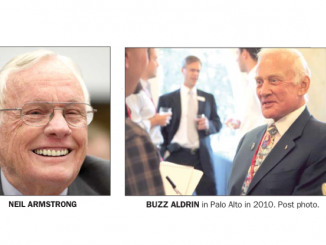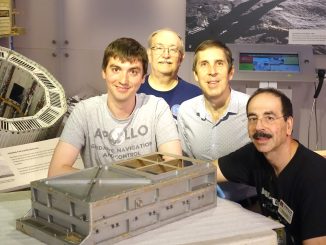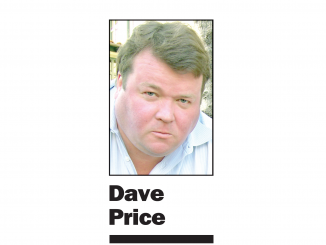
BY DAVE PRICE
Daily Post Editor
In the next couple of weeks, I suspect a lot of people will be thinking back to 50 years ago when man first landed on the moon.
It was July 20, 1969 when Neil Armstrong and Buzz Aldrin climbed out of the landing module called “Eagle” and stepped foot on the lunar surface.
The Post is asking readers to send us their stories about watching the mission of Apollo 11 live.
Where did you see it? Who were you with? Were you worried about the astronauts? What was your reaction and the reactions of those around you? What conversations came of it?
Email us at [email protected] and include your name and phone number, so we can contact you if we have questions.
It seems everybody who was alive back then has a story about the moon mission.
I don’t think there has ever been an historic achievement that has had as many witnesses — an estimated 600 million people watched Armstrong’s first steps on the moon when he spoke the immortal words, “That’s one small step for man, one giant leap for mankind.”
The mission carried enormous risks. There were fears they would crash into the moon, or that they wouldn’t be able to lift off from the lunar surface and dock with the command module piloted by Michael Collins.
The guidance computer in the Eagle crashed five times in four minutes as Armstrong was searching for a safe place to land.
The mission was so risky that President Nixon had his speech writer, William Safire, compose a national address in the event that the Armstrong and Aldrin died on the moon.
And when the astronauts returned, there was this quirky issue of whether they would bring back pathogens from the moon. Don’t laugh. We didn’t know for sure that the surface of the moon was sterile. So Congress had passed the “Extra-Terrestrial Exposure Law” saying the astronauts would have to be quarantined for 21 days to protect the public.
That’s why, when Nixon greeted the astronauts on the deck of the USS Hornet, they were seen looking at the president through the window of a hermetically sealed Jetstream trailer. The USS Hornet, now retired, is permanently docked in Alameda, and it’s open for public tours.
Not to be overlooked were the efforts of about 400,000 people who were involved in the space program, either as NASA employees or contractors. The cost of the mission was $25 billion. Critics (and, yes, there were critics of Apollo 11) said the money would have been better spent fighting poverty.
Much of the technology for the space program came from Silicon Valley, although this region wasn’t known by that name 50 years ago. We hope to print a story about the valley’s role in the space program closer to the anniversary of the moon walk. We have some additional features planned as well, like when Armstrong and Aldrin visited Palo Alto.
We’re hoping we can include your memories too. At left is a timeline of the Apollo 11 mission. I remember how everyone seemed to stop what they were doing just to watch each aspect of the journey, from the launch to the splashdown. It was an exciting time for everyone.
The following is a timeline of the Apollo 11 mission.
All times Pacific
July 16, 1969, 6:32 a.m. — Apollo 11 blasts off from Launch Pad 39A at Cape Kennedy, Florida, with Neil Armstrong, Edwin “Buzz” Aldrin and Lt. Col. Michael Collins on board.
July 19, 10:21 a.m. — Apollo 11 enters lunar orbit.
July 20, 10:46 a.m. — The lunar lander, named “Eagle,” separates from the command module, called “Columbia.”
July 20, 1:06 p.m. — Eagle lands on moon.
July 20, 7:56 p.m. — Armstrong steps foot on the moon and says “That’s one small step for man, one giant leap for mankind.”
July 20, 10:11 p.m. — Armstrong and Aldrin return to the lunar module and the hatch is closed. The two men sleep that night on the surface of the moon.
July 21, 10:54 a.m. — Eagle begins its ascent back to the command module.
July 21, 2:35 p.m. — Eagle successfully docks with Columbia, and Armstrong and Aldrin rejoin Collins.
July 21, 9:56 p.m. — Apollo 11 begins journey home.
July 24, 9:50 p.m. — Apollo 11 splashes down in the Pacific, 13 miles from the recovery ship USS Hornet.
Duration: 8 days, 3 hours, 18 minutes
Distance: 953,054 miles




I was at the Junior Assistant Scout Master at the Boy Scout National Jamboree in Farragut, Idaho. At the time, the Jamboree made up the second largest city in the State of Idaho (second to Boise). They raised giant sheets that were sewn together to make what looked like a drive-in theatre screen. We saw a projection broadcast of the Moon landing by Apollo 11. It was such a surreal experience. Hard to believe that 50-years later, I moved our 5th generation family out of California and ended up within 10-miles of Farragut!
I was given a complete set of 10 photos on archival paper of Apollo 11 by a journalist in 1969. The bottom depicts subject matter and a number. I can not find any photos like these, can you give me a little insight?
Thank YOU,
Lori Field
My grandfather was born in 1882 and had used horses for transportation before the automobile age. I remember sitting with him in front of the TV watching men step onto the moon. He was engrossed but not surprised that Mankind could accomplish this.